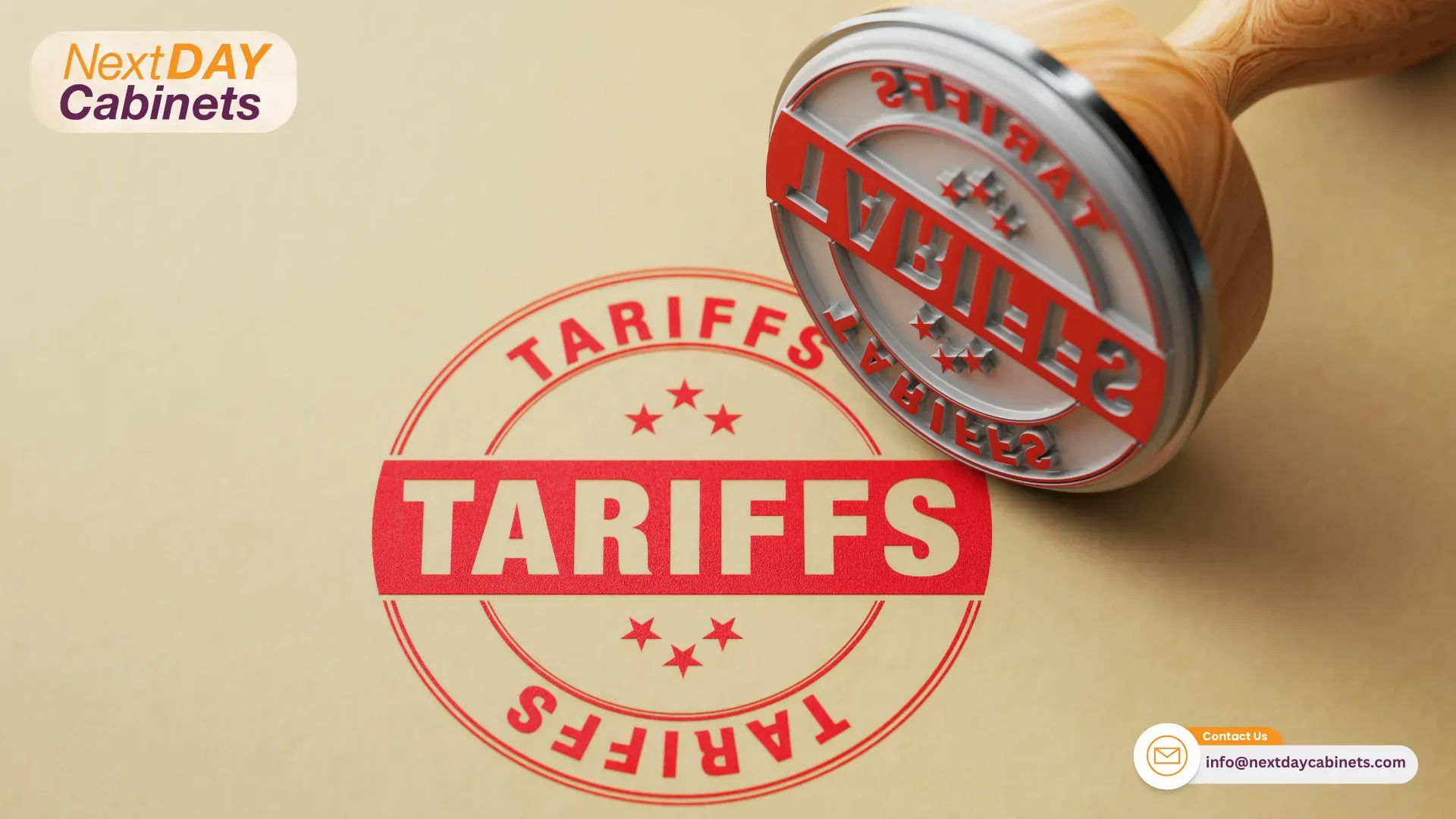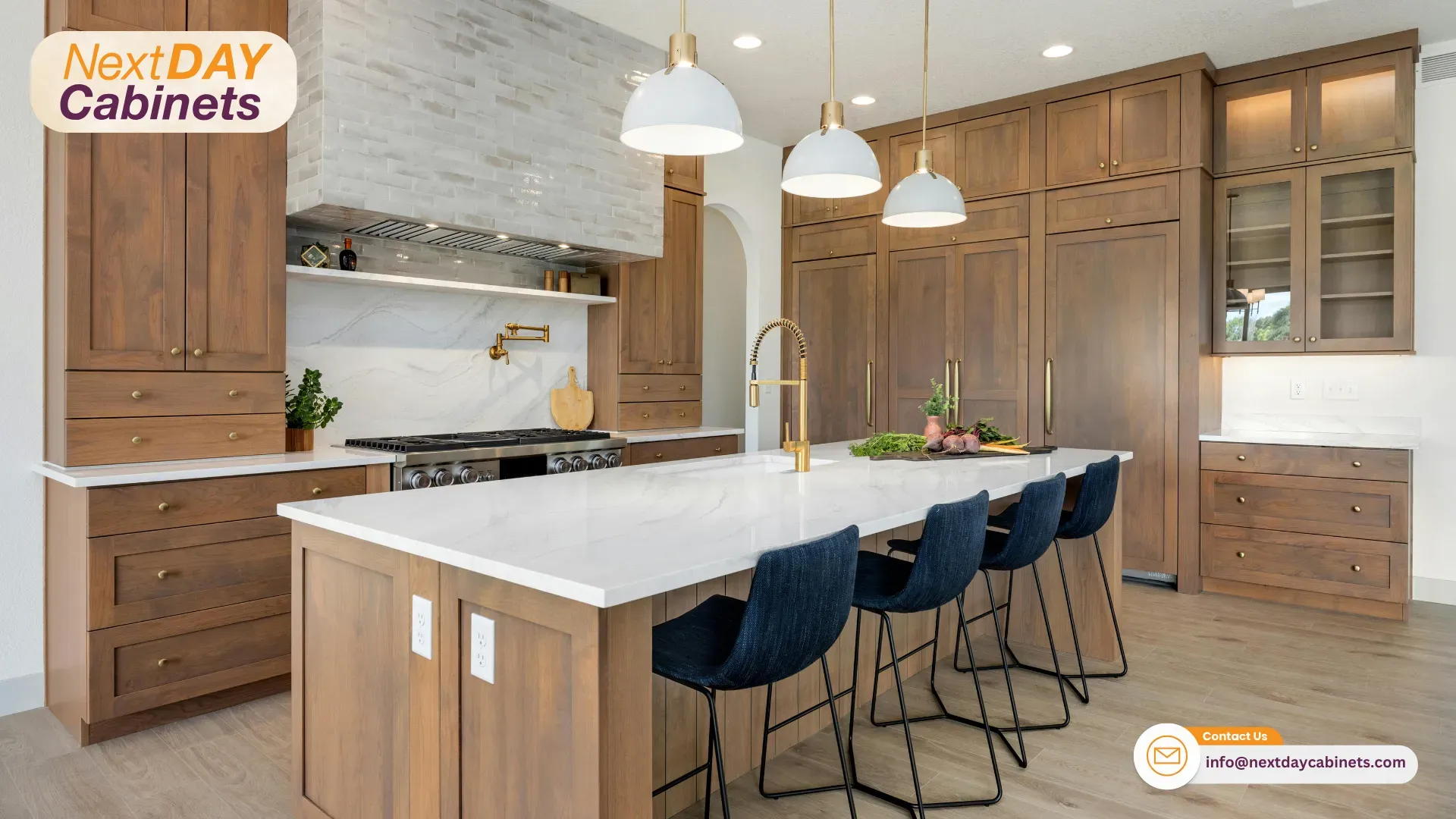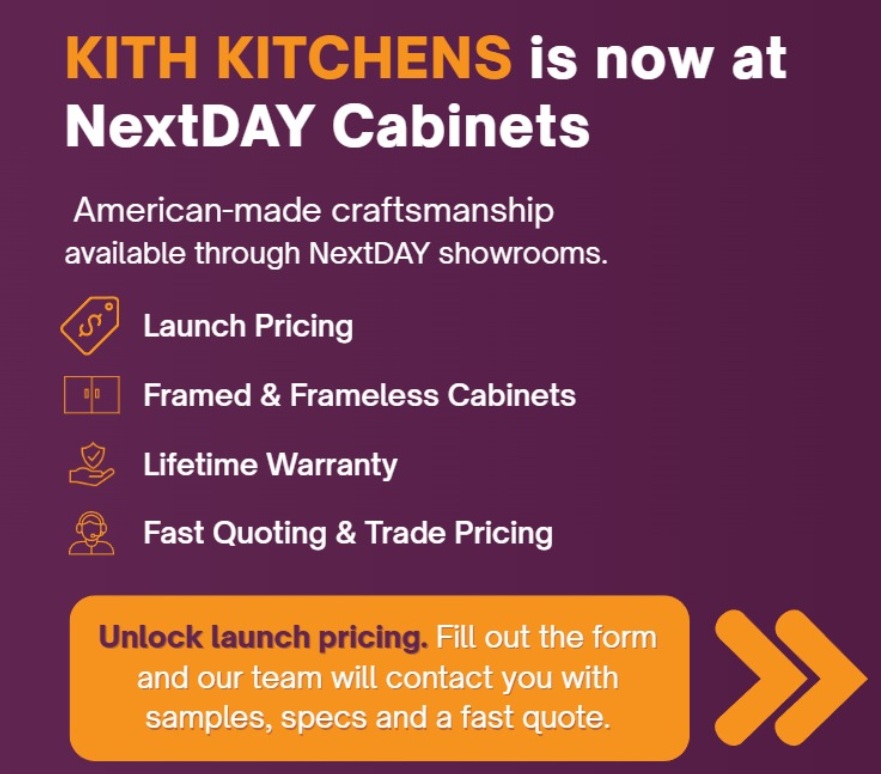
How New Tariffs Are Impacting the U.S. Cabinetry Industry
The U.S. cabinetry industry is facing a significant shift in 2025 as sweeping new tariffs are imposed on imported cabinets, raw materials, and hardware. For companies like NextDAY Cabinets and their customers, understanding these changes is crucial for making informed decisions about remodeling, construction, and sourcing cabinetry products. This blog post examines the latest tariff developments, their direct impact on the cabinetry sector, and how businesses and homeowners can respond.
Key Takeaways for How New Tariffs Are Impacting the U.S. Cabinetry Industry
- Significant New Tariffs in 2025: The U.S. government imposed sweeping new tariffs on imported cabinets, hardware, and raw materials, with rates up to 46% for Vietnamese cabinets, 25% for Canada and Mexico, and 20% for China, plus a general 10% tariff on all other countries.
- Immediate Price Increases: These tariffs are driving up the cost of imported cabinets and hardware, resulting in higher prices for remodeling, construction, and renovation projects across the country.
- Supply Chain Disruptions: Global supply chains are disrupted as companies that relied on imports scramble to find alternative suppliers, adjust contracts, and navigate new lead times and costs.
- Shift Toward Domestic Manufacturing: Demand for U.S.-made cabinets is rising as companies and consumers seek to avoid tariff-related price hikes, leading to potential growth in domestic production and jobs.
- Potential for Further Raw Material Tariffs: Ongoing investigations into raw materials like plywood and MDF could extend tariff impacts to U.S. manufacturers, possibly raising costs industry-wide.
- Widespread Impact Across the Industry: Homeowners, contractors, interior designers, and manufacturers all face challenges from higher prices, tighter margins, and increased uncertainty.
- NextDAY Cabinets’ Strategic Response: NextDAY Cabinets is prioritizing domestic manufacturing, partnering with U.S. suppliers, offering flexible design options, and maintaining transparent communication to help customers navigate these changes.
- Proactive Planning Is Essential: Industry professionals and homeowners are encouraged to plan projects early, consider domestic products, stay informed about policy changes, and work with experienced partners to successfully manage tariff-related risks.
What Are the New U.S. Tariffs in 2025?
In April 2025, President Trump signed a series of executive orders introducing sweeping reciprocal tariffs on imports from over 60 countries, targeting key industries such as kitchen cabinets, vanities, and their components. The most notable changes include:
- A baseline 10% tariff on imports from all countries, effective April 5, 2025.
- Vietnam, the largest supplier of cabinets to the U.S., now faces a 46% tariff.
- Canada and Mexico face 25% tariffs, while Chinese imports are subject to a 20% tariff.
- A 25% tariff on all steel and aluminum imports, affecting cabinet hardware and accessories 1 2 3.
These measures follow earlier anti-dumping duties on Chinese cabinetry, which had already shifted much of the U.S. import market to Vietnam and other Southeast Asian countries 2.

How Do New Tariffs Affect the Cabinetry Business?
1. Price Increases on Cabinets and Hardware
The most immediate impact is a rise in the cost of imported cabinets and hardware. With tariffs as high as 46% on Vietnamese products, prices for kitchen cabinets and vanities are expected to increase within weeks. Builders, remodelers, and homeowners may see higher quotes for both custom and stock cabinetry, potentially leading to tighter budgets or scaled-back projects 2 3 4.
2. Supply Chain Disruptions
Many U.S. cabinet companies rely on a global supply chain for raw materials, such as plywood, MDF, and hardware, as well as finished products. The new tariffs disrupt established sourcing channels, forcing companies to:
- Seek alternative suppliers in non-impacted regions.
- Increase domestic sourcing and manufacturing.
- Renegotiate contracts and timelines to accommodate changing costs and lead times 1 3.
3. Shifting Demand Toward Domestic Manufacturing
As imported cabinets become more expensive, demand for U.S.-made cabinets is increasing. Domestic manufacturers that produce in the U.S. are better positioned to avoid tariff-related price hikes and supply disruptions. This trend could lead to:
- Growth in local manufacturing jobs.
- Increased investment in U.S. production facilities.
- Shorter lead times and more reliable delivery for customers 2 3.
4. Uncertainty Over Raw Material Costs
While the current tariffs primarily target finished cabinets and hardware, ongoing investigations could extend to raw materials such as lumber, plywood, and MDF. If tariffs are imposed on these materials, even domestic manufacturers could face higher costs, potentially impacting the entire industry 1 3.
Who Is Most Affected by the New Tariffs on Cabinets?
- Homeowners: Those planning kitchen or bathroom renovations may face higher prices and longer wait times for cabinetry.
- Contractors & Remodelers: Tighter margins and unpredictable costs may require more flexible project planning and budgeting.
- Interior Designers: Rising material costs can disrupt carefully crafted design plans, requiring creative solutions and substitutions.
- Cabinet Manufacturers: Companies relying on imports must quickly adapt their supply chains, while domestic producers may see increased demand but also face pressure to control costs 4.
Strategic Responses: How NextDAY Cabinets Is Adapting
At NextDAY Cabinets, we are dedicated to delivering high-quality cabinetry solutions, even in a rapidly evolving trade environment. Here’s how we are navigating the new tariffs:
- Domestic Manufacturing: By prioritizing U.S.-made cabinets and sourcing as many materials domestically as possible, we minimize exposure to tariffs and maintain stable pricing for our customers.
- Supplier Partnerships: We collaborate closely with trusted U.S. suppliers for hardware and accessories, ensuring high-quality products and timely delivery.
- Flexible Design Options: Our team is ready to suggest alternative materials and finishes that offer great value without compromising on style or durability.
- Transparent Communication: We keep our customers informed about potential price changes and lead time adjustments, helping them plan their projects with confidence.
Tips for Homeowners and Industry Professionals
- Plan Ahead: Start your cabinetry project early to account for potential delays or price increases.
- Consider Domestic Products: Ask your supplier about U.S.-made cabinets and hardware to avoid tariff-related costs.
- Stay Informed: Follow updates from industry associations and government agencies for the latest on tariff changes.
- Work with Experienced Partners: Choose suppliers and contractors who are proactive in managing supply chain risks and transparent about pricing.

FAQs for the Impacts of New Tariffs in the U.S. on Cabinetry Industry
What countries does the US import from?
The U.S. imports cabinetry and related products from several countries, with major sources including China, Vietnam, Mexico, and Canada. These imports cover items like kitchen cabinets, vanities, hardware, and raw materials, which are essential for the U.S. cabinetry industry and its supply chain.
What is America’s #1 export?
America’s top export is machinery, including electrical machinery and computers. However, in the context of the cabinetry industry, U.S.-made cabinets are also a growing export as domestic manufacturers expand their reach abroad.
Why is the US putting tariffs on Canada?
The U.S. has imposed tariffs on Canadian lumber and wood products due to ongoing disputes over fair trade practices. These new tariffs impact the U.S. cabinetry industry by raising the cost of raw materials used in manufacturing kitchen cabinets and vanities, leading to price increases for contractors and consumers.
What country has a trade deficit with the US?
The U.S. has a trade deficit with China, importing more goods than it exports. This includes a large volume of cabinetry and related products, which has contributed to the ongoing tariff discussions and price fluctuations in the cabinetry sector.
What is China’s tariff rate on U.S. goods?
China currently imposes a 125% tariff on most U.S. goods, a rate that was raised from 84% in direct response to recent U.S. tariff hikes. This escalation is part of the ongoing trade conflict and affects a wide range of American exports, including raw materials and finished products relevant to the U.S. cabinetry industry.
What tariffs are currently in effect between the U.S. and China?
The U.S. has implemented a 145% tariff on most imports from China, which includes imported cabinets, kitchen cabinets, vanities, hardware, and many other products. These new tariffs are layered on top of previous anti-dumping and countervailing duties that can reach up to 269% for Chinese-made kitchen cabinets and vanities. In response, China has set its own tariff on U.S. goods at 125%. Other countries, like Vietnam, Canada, and Mexico, face different rates, but China is currently subject to the highest tariffs.
What is a tariff in the United States?
A tariff in the United States is a tax imposed on imported goods at the border. Tariffs are used to make imported products, such as kitchen cabinets, vanities, and hardware, more expensive compared to U.S.-made cabinets. This aims to protect domestic manufacturing, encourage the use of U.S.-made products, and address unfair trade practices. Tariffs can be specific (fixed amount per item), ad valorem (percentage of value), or a combination, and are often used as a tool to influence supply chains and support local industries like the U.S. cabinetry industry.
What is the current tariff rate in the U.S.?
As of April 2025, the average effective tariff rate in the U.S. is about 28%, the highest since 1901. For imports from China, the rate is much higher—up to 145% for most goods, including imported cabinets and related products. Tariffs on imports from other countries, such as Vietnam, Canada, and Mexico, vary but are generally lower than those imposed on China. These new tariffs are expected to increase the cost of imported kitchen cabinets, vanities, and hardware, leading to price increases for contractors, interior designers, and homeowners, and shifting demand toward domestic cabinet manufacturers.
How are new tariffs affecting the U.S. cabinetry industry?
The new tariffs are causing significant price increases for imported cabinets, vanities, and hardware, especially those from China. This is disrupting supply chains, increasing costs for remodeling projects, and encouraging contractors and interior designers to source more U.S.-made cabinets. Domestic cabinet manufacturers are seeing increased demand as a result, but the overall market is facing volatility and uncertainty due to ongoing trade tensions and rapidly changing tariff rates.
What does China buy from the U.S.?
China imports agricultural products, aircraft, machinery, and energy resources like soybeans, pork, commercial jets, and natural gas from the U.S. These goods support China’s food security, industrial growth, and energy needs, though trade volumes fluctuate due to tariffs and global demand.
How have new tariffs affected the U.S. cabinetry industry?
New tariffs have increased costs for imported cabinets, raising prices for kitchen cabinets and vanities by 10-25%. The U.S. cabinetry industry faces supply chain challenges as tariffs on Chinese raw materials and hardware drive up production costs. Many cabinet manufacturers are shifting to domestic manufacturing or sourcing from Vietnam, Canada, or Mexico, but price increases impact remodeling projects, contractors, and interior designers.
Which country has the highest import tax in the United States?
China faces the highest import tax in the U.S., with tariffs reaching up to 145% on goods like imported cabinets and hardware. These new tariffs, aimed at protecting domestic manufacturing, significantly affect the U.S. cabinetry industry, encouraging a shift toward U.S.-made cabinets and alternative suppliers like Vietnam.

Looking Ahead: The Future of Cabinetry in a Tariff-Driven Market
The new tariffs mark a turning point for the U.S. cabinetry industry. While challenges persist, opportunities also exist for innovation, growth in domestic manufacturing, and closer collaboration across the supply chain. At NextDAY Cabinets, we remain committed to delivering exceptional value and service, helping our customers create their dream spaces—no matter what challenges come our way.
NextDAY Cabinets is closely monitoring the impact of new tariffs to provide customers with the most accurate, up-to-date insights and solutions for their cabinetry projects.
Resources
-
HDI Cabinetry Blog:
Navigating New Tariffs: Implications for the Cabinet Industry and Potentially Some of Our Products
https://hdicabinetry.com/2025/03/08/navigating-new-tariffs-implications-for-the-cabinet-industry-and-potentially-some-of-our-products/ -
CabinetryNews.com / EIN Presswire
President Trump Signs Reciprocal Tariffs Executive Orders That Will Impact The Cabinetry Industry
https://www.einpresswire.com/article/799681542/cabinetrynews-com-president-trump-signs-reciprocal-tariffs-executive-orders-that-will-impact-the-cabinetry-industry -
LinkedIn
How New US Tariffs Affect Kitchen Cabinet Imports & Raw Materials
https://www.linkedin.com/pulse/how-new-us-tariffs-affect-kitchen-cabinet-imports-raw-materials-gj5cc/ -
ModernTwenty Furniture Blog
How Tariffs Will Impact the Price of Your Cabinets
https://www.moderntwentyfurniture.com/how-tariffs-will-impact-the-price-of-your-cabinets/


